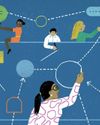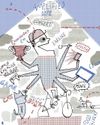Corporate inclusion programs often trigger an us-versus-them mind-set. But establishing shared goals can help get teams on track.

Although diversity and inclusion training is prevalent in corporate America, its impact is inconsistent. Sometimes the programs even have the opposite effect of what they intend. One 2016 study of 830 mandatory diversity training programs found that they would trigger a strong backlash against the ideas they promoted. “Trainers tell us that people often respond to compulsory courses with anger and resistance,” wrote sociologists Frank Dobbin and Alexandra Kalev in the Harvard Business Review, “and many participants actually report more animosity toward other groups afterward.”
The problem is not with the programs themselves. They make a strong, consistent case for valuing differences — not just because it’s the right thing to do, but because it leads to much higher levels of performance. Inclusive companies have a demonstrated advantage, both financially and in general levels of innovation. And being around others from different backgrounds makes people more creative and hardworking. Drawing on multiple perspectives leads teams to see a greater number of solutions to problems.
Why, then, does diversity and inclusion training spark a backlash? The answer has to do with biases deeply entrenched in most people’s patterns of thinking — attitudes not about race or gender per se, but about the nature of autonomy and group membership. The political conflicts around “political correctness” and inclusiveness stem from the same cognitive issues. That in itself makes the negative reaction to inclusion training worthy of study. If businesses can’t create an environment in which employees from diverse backgrounds feel they are treated equitably, how can we expect society to do so?
Diese Geschichte stammt aus der Fall 2017-Ausgabe von strategy+business.
Starten Sie Ihre 7-tägige kostenlose Testversion von Magzter GOLD, um auf Tausende kuratierte Premium-Storys sowie über 8.000 Zeitschriften und Zeitungen zuzugreifen.
Bereits Abonnent ? Anmelden
Diese Geschichte stammt aus der Fall 2017-Ausgabe von strategy+business.
Starten Sie Ihre 7-tägige kostenlose Testversion von Magzter GOLD, um auf Tausende kuratierte Premium-Storys sowie über 8.000 Zeitschriften und Zeitungen zuzugreifen.
Bereits Abonnent? Anmelden

Transforming information into insight
Focus on six organizational elements to build a world-class data and insights capability.

THE URGENT NEED FOR SOPHISTICATED LEADERSHIP
The pandemic has highlighted a series of paradoxes inherent to the work of leaders. What comes next will depend on how well leaders face up to them.

The road to successful change is lined with trade-offs
Rather than trying to convince people your change initiative is the right one, invite them to talk openly about what it might take to implement it: the good, the bad, and the frustrating.

Sustaining productivity virtually
Maintaining productivity levels among remote employees is an enduring challenge. Here are five ways to help businesses and employees thrive while people work at home.

FORWARD TO normal
Entertainment and media companies are building business models that are resilient to the enduring changes in consumer behavior ushered in by COVID-19.

How leaders can promote racial justice in the workplace
Embrace four principles to turn today’s diversity, equity, and inclusion initiatives into sustained progress.

CREATING THE OFFICE OF THE FUTURE
In a remodeled world, it is vital for companies to reinvent ways of working.

Consumer companies must take leaps, not steps
As shoppers show how quickly they can adapt to external shocks, retailers will need to radically reconfigure their business models.

Businesses can fast-track innovation to help during a crisis
“Unrealistic” timelines can actually work. Here’s how.

Agility and experience management work better together
Many companies achieve early wins with separate transformational efforts, then stall. But if combined and enhanced using “return on experience,” or ROX, measures, these two programs can unlock each other’s potential.